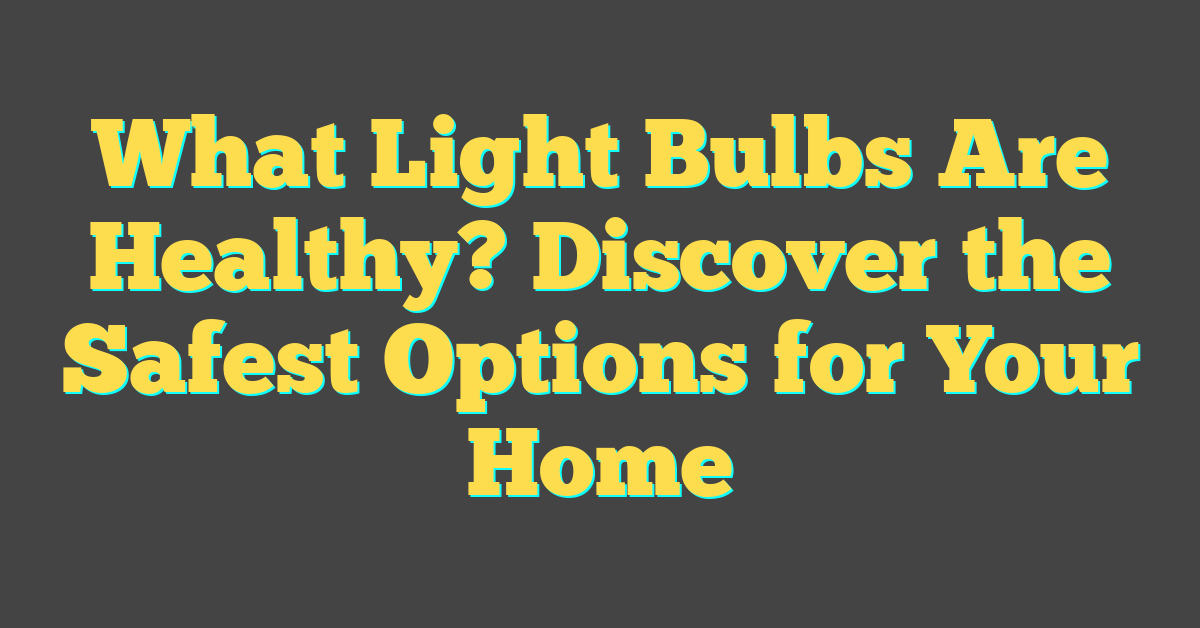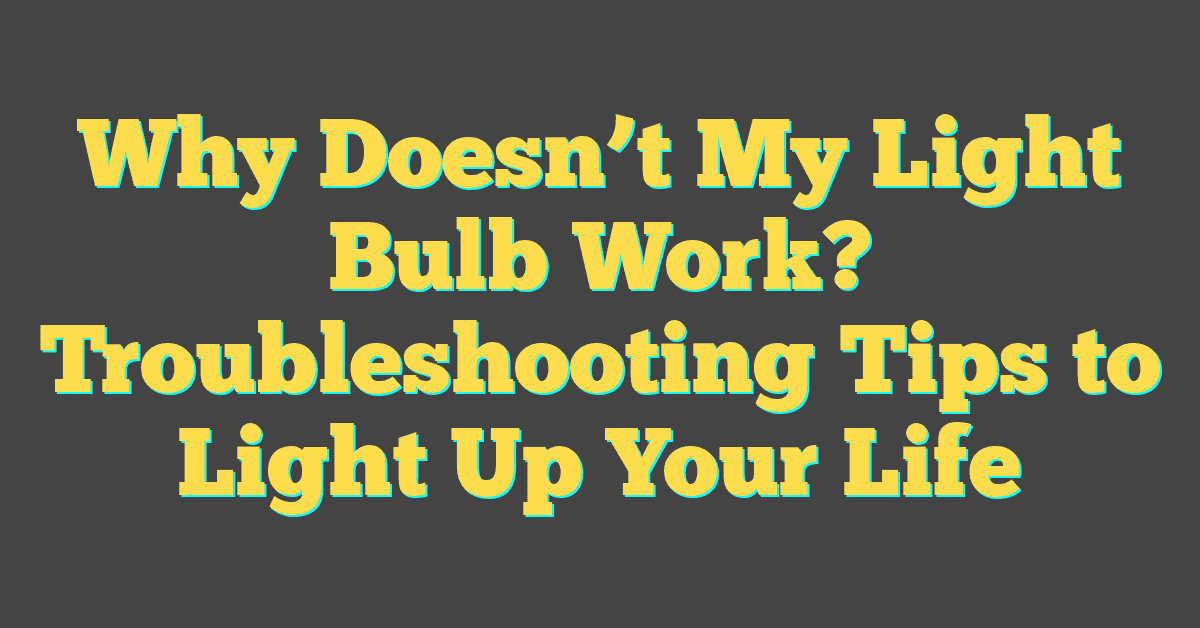Ever thought about how the light bulbs flickering above could be affecting your health? It’s not just about setting the mood or brightening up a room; the right lighting can actually make a difference in how you feel.

You might be surprised to learn that not all light bulbs are created equal when it comes to your well-being. From eye strain to sleep patterns, the bulbs you choose can have a real impact.
The Importance of Choosing Healthy Light Bulbs
You wouldn’t select just any ingredient for your favorite home-cooked meal, so why compromise on the light bulbs that illuminate your living spaces? Picking the right light bulb is as crucial as choosing a comfortable mattress or ergonomic chair for your well-being.
Natural light is the gold standard for maintaining a healthy circadian rhythm; nonetheless, it’s not always accessible. That’s where the savvy selection of artificial lighting comes into play. You’ve got to ensure the artificial light resembles natural sunlight as closely as possible. This is vital not just for your visual comfort but also for regulating sleep patterns and mood.
Consider this: bulbs emitting a blue light spectrum can hinder the production of melatonin, the hormone responsible for sleep. So, it’s smart to avoid these types of light bulbs in the evening and instead opt for ones that emit a warmer tone. Several options are designed to minimize blue light exposure, particularly beneficial in spaces used during evening hours.
LED lights are often touted for their energy efficiency, but it’s not just about saving on the electricity bill. High-quality LED bulbs often come with an option to adjust color temperature, which caters to your activities throughout the day. In the morning, a cooler light invigorates and helps wake you up, whereas a warmer glow in the evening sets the tone for relaxation.
Here’s another nugget for your DIY projects: pay attention to the Color Rendering Index (CRI) of light bulbs. A CRI closer to 100 means the light source is excellent at revealing the true colors of the objects it illuminates, much like natural light. This could make all the difference in your crafting room or kitchen, enhancing both the functionality and aesthetics of your space.
- Choose bulbs resembling natural sunlight
- Opt for warmer tones in the evening to promote sleep
- Look for adjustable color temperature LED lights
- Target high CRI bulbs for accurate color representation
Remember, your home is your haven. With a little knowledge and the right light bulbs, you can create a sanctuary that looks great, feels comfortable, and supports your health.
Understanding Different Types of Light Bulbs
When you’re on the hunt for the perfect bulb, it’s crucial to know what you’re up against. There are several types of light bulbs, each with unique features that can cater to your health and environmental needs.
Incandescent Bulbs: These are your traditional bulbs that have been around for ages. They produce a warm light that’s quite similar to natural sunlight, but they’re not the most energy-efficient option. If you like to kick it old-school and aren’t too bothered about your energy bill, they might just be your go-to. However, for those of you who are environmentally conscious and looking to cut down on energy consumption, you might want to consider other options.
Compact Fluorescent Lamps (CFLs): CFLs are a step up in the energy-saving ladder. They use about 70% less energy than incandescent bulbs and can last up to 10 times longer. But here’s the kicker: they contain a small amount of mercury, making them a bit tricky to dispose of safely. Make sure you’re following proper disposal guidelines to keep the environment safe.
Light Emitting Diodes (LEDs): The new kids on the block, LEDs are a game-changer in the world of artificial lighting. They’re highly energy-efficient, have a long lifespan, and, unlike incandescent bulbs, don’t give off a lot of heat. Best yet, they come with adjustable color temperatures, which means you can switch from a bright daylight hue for productivity to a softer, warmer tone for evening relaxation. They’re also available with high CRI, enhancing the color vibrancy in your space.
Choosing the right bulb isn’t just about saving money on your energy bills or being a friend to the environment; it’s about your health too. You’ve probably put a lot of thought into the paint on your walls and the furniture in your rooms—don’t let the wrong light bulb throw off your carefully curated ambiance. Consider how different bulbs can affect your circadian rhythm and mood throughout the day. Go for bulbs that mimic natural light as closely as possible, especially if you spend a lot of time indoors.
Remember, the right lighting can transform your home into a sanctuary for your well-being. With a dash of DIY spirit and a keen eye on your health, you’ll find the perfect glow for every corner of your living space.
How Light Bulbs Affect Eye Health
« Is F Energy Rating Good for Light Bulbs? See How It Impacts Your Bills
What Causes Light Bulbs to Blow Out? Prevent Burnouts Now »
Did you know that the kind of light bulb you choose can have a significant impact on your eye health? Choosing the right bulb isn’t just about the ambiance – it’s also about protecting one of your most precious senses.
Exposure to harsh lighting can lead to discomfort, and in some cases, eye strain or fatigue. This is something you’ll want to avoid, especially if you spend a lot of time under artificial light. Incandescent bulbs, while warm, often don’t provide the most consistent light, which can lead to squinting and strain over time.
On the other hand, CFLs offer more consistent illumination but remember their bluer light can be harsh on the eyes, especially without proper shades or diffusers. Plus, there’s that bit about the small amount of mercury they contain – not ideal for your health if a bulb breaks.
LEDs are your eye’s best friend here. Not only are they energy-efficient, but they also come with the added advantage of adjustable color temperatures, which means you can personalize your space to have warmer tones that are generally gentler on the eyes. Moreover, LEDs with a high Color Rendering Index (CRI) ensure that the colors you see are accurate, reducing the strain that comes from poor lighting.
When installing lights around your home, consider task lighting – that’s a fancy term for lighting designed for specific activities, like reading or cooking. Getting this right will save your eyes from having to work overtime. So when you’re knee-deep in a DIY home project, proper task lighting can make all the difference.
Remember, your eyes aren’t just windows to the soul; they’re your daily companions through every task. So, invest wisely in your bulbs, because when it comes to eye health, every little bit counts. Keep in mind that beyond type, bulb placement and intensity are crucial elements too. Ensure they’re just right – not too dim, not too bright. Your future self will thank you, trust me.
The Impact of Light Bulbs on Sleep Patterns
You might not immediately link the quality of your sleep to the bulbs flickering in your lamps, but they’re more connected than you’d think. The type of light bulb you choose can significantly affect your circadian rhythm, that built-in clock that tells you when it’s time to wake up or wind down.
Color Temperature Matters. Look for bulbs with a lower Kelvin (K) rating for your bedroom. Warmer, yellow-hued lights around 2700K to 3000K mimic the sunset and signal your brain to produce melatonin, the sleep hormone.
If you’ve ever switched on a bright light during a midnight trip to the bathroom, you’ve felt its jarring effect. It’s not just the wattage at play here, but also the color temperature. Bulbs with higher Kelvin values – above 3500K – are cooler, blue-toned lights. They’re great for mimicking daylight, boosting concentration, and keeping you alert during the day, but they’re sleep’s nemesis come nighttime.
Smart Lighting to the Rescue. Embrace technology and try smart bulbs that let you adjust color temperatures throughout the day. Transition from cool, invigorating light in the morning to a warm, relaxing glow as evening falls.
- Morning: 5000K – 6500K, to kickstart your day
- Afternoon: 3000K – 4500K, to maintain steady focus
- Evening: Under 3000K, to prepare your body for sleep
Here’s a hot tip: avoid screens an hour before bed. Your smartphone and tablet also emit that sleep-disrupting blue light, so it’s not just about the bulbs.
Remember, it’s not just about brightness. The quality of light is key. Regularly using the appropriate light settings can help regulate your sleep patterns. Trust me, your body will thank you for paying attention to these subtle but crucial details. Opt for lights that come with a “night mode” or invest in dimmers to reduce intensity as bedtime approaches.
Your lighting choices can make or break your sleep hygiene. By making small changes and becoming conscious of the lights you use when the sun goes down, you’ll enhance your environment, comfort, and, ultimately, your well-being.
Tips for Choosing Healthy Light Bulbs
When you’re on the hunt for the best light bulbs to promote health and well-being, there are a few key factors to keep in mind. First off, consider the bulb’s color temperature. This is indicated in Kelvin (K) and can make all the difference in aligning your body’s natural rhythm to your environment. A lower Kelvin rating, which yields a warmer, more amber glow, is ideal for the evenings. It encourages relaxation and can help cue your body that it’s time to wind down.
As you’ve learned, bulbs around 2700K to 3000K are great for bedrooms, while those with a higher Kelvin, such as over 3500K, provide a cooler, daylight-like quality that’s better suited for mornings and workspaces. But there’s more to consider than just color.
Look for bulbs with adjustable brightness levels. Having the option to dim your lights as the evening progresses not only sets a cozy atmosphere but also reduces your exposure to bright light when you’re gearing up for bed. Dimmable LEDs are popular for their longevity and energy efficiency, plus they’re available in various color temperatures.
Consider trying out smart bulbs, which often integrate seamlessly with home automation systems. The great part about smart bulbs is their programmability. You can set them to gradually dim as bedtime approaches or to simulate a natural sunrise to wake you gently in the morning. They come with the added bonus of controlling them right from your smartphone or voice assistant.
For those of you who are avid readers or crafters, task lighting is another healthy lighting option. These focused light sources help prevent eye strain by delivering direct light precisely where it’s needed without flooding the area with bright light that can mess with your sleep cycle.
Don’t forget to factor in energy efficiency. LED bulbs might have a higher upfront cost, but they pay off in the long run by using up to 80% less energy than traditional incandescent bulbs and lasting much longer. This means fewer bulb changes and less waste – great for your pocket and the planet.
By paying attention to these details, you’ll find it easier to choose bulbs that match your lifestyle and contribute to a healthier living space. Remember, lighting isn’t just about seeing better; it’s about living better.
Conclusion
You’ve got the power to transform your living space into a health haven just by selecting the right light bulbs. Remember, it’s all about balance—warm, low Kelvin bulbs for unwinding in the evening, and brighter, higher Kelvin bulbs to energize your mornings and work areas. Adjustable brightness and smart features are your friends, helping you sync your life with natural rhythms. And don’t forget, opting for energy-efficient LEDs is not only good for your health but also kind to your wallet and the planet. Here’s to brightening up your world in the healthiest way possible!
Frequently Asked Questions
What factors should I consider when choosing a healthy light bulb?
When selecting a healthy light bulb, consider its color temperature (opt for lower Kelvin ratings in the evening), adjustable brightness levels, and whether it’s programmable such as smart bulbs. Energy efficiency and task lighting suitability are also important considerations.
Can the color temperature of a bulb affect my health?
Yes, the color temperature can affect your health. Bulbs with lower Kelvin ratings can promote relaxation in the evening, while those with higher Kelvin ratings are better for alertness and concentration in the morning or workspaces.
What are smart bulbs and how can they promote better sleep?
Smart bulbs are programmable light bulbs that can be set to change brightness and color temperature throughout the day. They can simulate a natural sunrise to wake you up gently or gradually dim to help prepare your body for sleep.
Why is task lighting recommended for readers or crafters?
Task lighting is recommended because it provides focused light, reducing eye strain for activities that require concentration, such as reading or crafting. It also allows for better visual clarity and can prevent fatigue.
Are LED bulbs more energy-efficient than other types?
Yes, LED bulbs are more energy-efficient compared to traditional incandescent bulbs. They use less electricity and have a longer lifespan, which can help reduce energy consumption and lower electricity bills.








